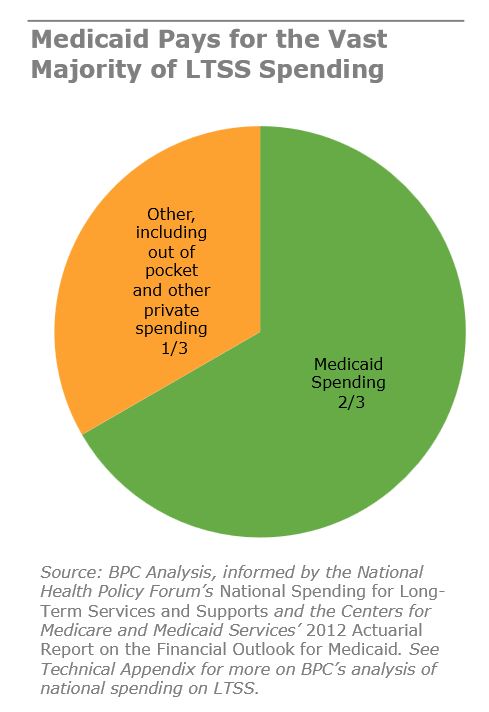Bipartisan Policy Center Launches Long-Term Care Initiative
The enormous cost of providing long-term care represents a major challenge for America's health system, and a major funding challenge for Medicaid, the public program that covers much of the cost of long-term care. To identify a solution to this challenging problem, the Bipartisan Policy Center (BPC) recently launched a Long-Term Care Initiative (LTCI) to find a politically and fiscally viable path forward to improve the financing and delivery of long-term services and supports (LTSS). The report released Monday accompanied by a panel discussion of the initiative's leaders detailed the LTSS problem and BPC's approach toward finding policy options, which they will release later this year.
Currently, paying for long-term care (such as in-home assistance and nursing homes) presents a major challenge for many families, draining the savings of many seniors until they qualify for low-income assistance through Medicaid. The costs place a burden on families who struggle to afford necessary care, states, and the federal government. Medicaid spends over $100 billion annually on LTSS. Family and friends acting as unpaid caregivers also provide services each year worth more than $450 billion, but the cost of these unpaid services is not accounted for in total LTSS spending.
Even as expensive as the current system is, the costs of long-term care are set to grow dramatically if current demographic and health care cost trends continue. By 2050, the report highlights that the number of Americans who will need LTSS is expected to be 27 million, more than double the 12 million in 2010. Costs are also expected to rise from 1.3 to 3 percent of GDP. Acting now to reform the long-term care system, both delivery and payment methods, can help to get costs under control before they become overwhelming.
Reform is complicated for a number of reasons. LTSS has many stakeholders, including those who require services, their family, paid caregivers, providers, private insurers, states, and the federal government. Additionally, there is significant diversity among the population of individuals who require LTSS. They are not all elderly, in fact 44% of the population is under age 65. The type of care required varies significantly across this population, which results in wide variation in the level of assistance required.
Source: Bipartisan Policy Center
There is substantial debate over the best path forward. Expansion of the limited private insurance market is one possibility; however, the market would require significant reforms and government intervention to work efficiently. Another option is public assistance expansion through Medicaid. Both face strong headwinds of resistance.
In their paper released yesterday, BPC stated they seek to:
"(1) identify the most pressing problems associated with the current system of providing LTSS in the United States; (2) identify the barriers to finding a sustainable means of financing and delivering LTSS; and (3) outline some of the more critical policy questions that will guide BPC’s work in the coming months. Given the disparate populations in need of LTSS, and the challenges both in terms of politics and budgets, a solution to financing LTSS will likely require a series of policy options—including public and private options as well as long-term and short-term options—and will require legislative and regulatory changes. In the coming months, BPC leaders, staff, and senior advisors will reach out to experts, stakeholders, and policymakers and, later this year, present bipartisan policy approaches that we hope will move the dialogued forward. Importantly, as in A Bipartisan Rx, BPC will also work with economists and actuaries to estimate costs and savings associated with these policy solutions. We believe that developing a realistic, politically viable set of policy options is not only achievable, but is also imperative to relieve the pressure on persons who need LTSS, their families and caregivers, and local, state, and federal governments."
Given that the financial and social costs of long-term care will only continue to grow, BPC's initiative will begin much needed debates and conversations. We look forward to their policy options later this year.




